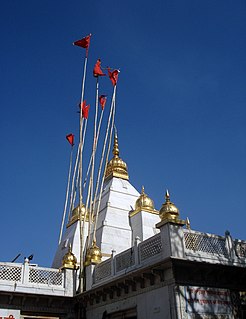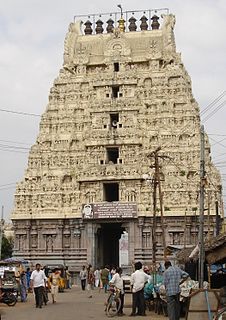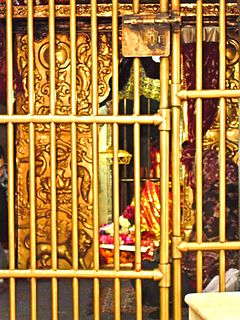
In Hinduism, goddess Shakambhari is an incarnation of Mahadevi. Her name means "The One who nourished mankind with fruits and vegetables". It is said that in the end of a hundred-year lasting famine, the supreme Paramashakti incarnated as Shatakshi-Shakambhari and gave food to the starving. Shakambhari devi is the third form of the Mother as depicted in the "Murti Rahasyam" part of "The Devi-mahatmyam" or most popularly, "Sri Sri Durga Saptashati/Sri Sri Chandi", the others being Nandadevi, Raktadantika, Durga, Bhimaa, and Bhraamari. There are many Shakti Peethas in our country, dedicated to this goddess, the prominent ones being Sakray peeth and Sambhar Peeth, located in Rajasthan and very famous Saharanpur Shaktipeeth in Uttar Pradesh.

The Shakti Pitha are significant shrines and pilgrimage destinations in Shaktism, the goddess-focused Hindu tradition. There are 51 Shakti peethas by various accounts, of which 18 are named as Maha (major) in medieval Hindu texts.

Mata Naina Devi is a town and a municipal council in Bilaspur district in the Indian state of Himachal Pradesh.
Ambaji (Ambājī) is a census town in Banaskantha district in the state of Gujarat, India. It is known for its historical connections with sites of cultural heritage.

The Kamakshi Temple is an ancient Hindu Temple dedicated to Kamakshi, the ultimate Goddess Lalita Maha Tripura sundari. It is located in the historic city of Kanchipuram, near Chennai, India. The Meenakshi Temple in Madurai, the Akilandeswari temple in Thiruvanaikaval near Tiruchirappalli and this Kamakshi temple are the important centers of worship of Goddess, in the state of Tamil Nadu. The Temple was most probably built by the Pallava kings, whose capital was Kanchipuram.

Saptashrungi or Saptashringi is a site of Hindu pilgrimage situated 60 kilometres (37 mi) from Nashik in Indian state of Maharashtra. According to Hindu traditions, the goddess Saptashrungi Nivasini dwells within the seven mountain peaks. It is located in Nanduri, Kalwan taluka, a small village near Nashik in India. The Marathas and some Bhil tribes worship the goddess from a long time and some worship as their kuldaivat. There are 510 steps to climb the gad. Devotees visit this place in large numbers every day. The temple is also known popularly as one of the "three and half Shakti Peethas" of Maharashtra. The temple is also one among the 51 Shakti Peethas located on the Indian subcontinent and is a location where one of Sati's limbs, her right arm is reported to have fallen. Its half shaktipeeth among three and half shaktipeeth of Maharashtra.

The Vishalakshi Temple or Vishalakshi Gauri Temple is a Hindu temple dedicated to the goddess Vishalakshi, at Mir Ghat on the banks of the Ganges at Varanasi in Uttar Pradesh, India. It is generally regarded as a Shakti Pitha, the most sacred temples dedicated to the Hindu Divine Mother.

Tarapith is a Hindu temple in Chandipur village Rampurhat II CD block in Rampurhat subdivision of Birbhum district of the Indian state of West Bengal, known for its Tantric temple and its adjoining cremation grounds where sādhanā are performed. The Tantric Hindu temple is dedicated to the goddess Tara, a fearsome Tantric aspect of the Devi, the chief temples of Shaktism. Tarapith derives its name from its association as the most important centre of Tara worship.

Chintpurni is a small town in the Una district of Himachal Pradesh about 40 km north of Una, not far from the border with the Indian state of Punjab. The elevation is about 977 meters. It is home to the Maa Chintpurni Temple which is a major pilgrimage site as one of the Shakti Peethas in India. The Hindu genealogy registers at Chintpurni, Himachal Pradesh are kept here. North of Chintpurni are the western Himalayas. Chintpurni lies within the much lower Shiwalik range.

Guhyeshwari Temple, also spelled Guheswari or Guhjeshwari, is one of the revered holy temples in Kathmandu, Nepal. This temple is dedicated to Guhyeshwari or Adi Shakti. The temple is also a Shakti Peetha and is about 1 km east of Pashupatinath Temple and is located on the southern bank of the Bagmati River. It is said that this temple is the Shakti chair of Pashupatinath Temple. It is an important pilgrimage destination for Hindus, especially for Tantric worshipers. King Pratap Malla built this temple in the 17th century. The goddess is also called Guhyekali.

Vaidyanatha Jyotirlinga temple, also known as Baba Baidyanath dham and Baidyanath dham is one of the twelve Jyotirlingas, the most sacred abodes of Shiva. It is located in Deoghar in the Santhal Parganas division of the state of Jharkhand, India. It is a temple complex consisting of the main temple of Baba Baidyanath, where the Jyotirlinga is installed, and 21 other temples.

In Hinduism, the yatra (pilgrimage) to the tirthas has special significance for earning the punya needed to attain the moksha (salvation) by performing the darśana, the parikrama (circumambulation), the yajna, the Dhyana, the puja (worship), the prarthana, the dakshina, the seva, the bhandara, etc. These sacred places are usually located on the banks of sacred water bodies, such as sacred rivers or their tributaries, the kundas, the ghats, or the stepwells, or the temple tanks.

The Mangla Gauri temple in Shakti Peetham, Gaya, Bihar, India has been mentioned in Padma Purana, Vayu Purana and Agni Purana and Devi Bhagvata Purana and Markandeya Purana in other scriptures and tantric works. This temple is among the eighteen maha shaktipeeth. The present temple dates back to the 15th century. The shrine is dedicated to Sati or the Mother Goddess in the predominantly Vaishnavite pilgrimage center of Gaya. Mangalagauri is worshiped as the Goddess of benevolence. This temple constitutes an Upa-Shakti Peeth — where it is believed that a part of the body of Sati fell according to mythology. Here Sati is worshipped in the form of a breast, a symbol of nourishment. It is believed that whoever comes to Maa Durga with his wishes and prayers, returns successfully with all of prayers and wishes come true.
Jeshoreshwari Kali Temple is a famous Hindu temple in Bangladesh, dedicated to the goddess Kali. The temple is located in Ishwaripur, a village in Shyamnagar upazila of Satkhira. The name "Jeshoreshwari" means "Goddess of Jeshore".

The Taratarini Temple on the Kumari hills at the bank of the River Rushikulya near Brahmapur city in Ganjam District, Odisha, India is worshiped as the Breast Shrine and manifestations of Adi Shakti. The Tara Tarini Shakti Peetha is one of the oldest pilgrimage centers of the Mother Goddess and is one of four major ancient Tantra Peetha and Shakti Peethas in India.
Shivaharkaray or Karavipur is a Shakti Peeth dedicated to the Hindu Goddess Durga, located near Parkai railway station, near Karachi, Pakistan. It is one of the two Shakti Peethas in Pakistan, other being Hinglaj Mata mandir Puranas describe that the three eyes of the Goddess fell here after she committed Sati. The Goddess is worshipped as Mahishasuramardini, or the slayer of the Demon Mahishasur. Her consort, the Hindu God Shiva, is worshipped in Ragi form as Krodhish, personification of anger. Shivaharkaray is third in the list of 51 Peethas identified in the Puranas.

Jayanti Devi Temple lies at Jayanti Majri village hillock, which is 15 km from Chandigarh in Mohali district of Punjab.
Shri Shri Mahalakshmi Bhairabi Griba Maha Peetha is one of the Shakti Peeths, at Joinpur village, Dakshin Surma, near Gotatikar, 3 km south-east of Sylhet town, Bangladesh. The Hindu Goddess Sati's neck fell here. The Goddess is worshipped as Mahalakshmi and the Bhairav form is Sambaranand.
In religion and spirituality, a pilgrimage is a very long journey or search of great moral significance. Sometimes, it is a journey to a sacred area or shrine of importance to innate faith. Members of every major religion participate in pilgrimages. A person who makes such a journey is called a pilgrim.

The temple of Attahas, also known as Fullora Attahas, is believed to be one of the 51 Shakti Peethas at which the body parts and jewelry of the Hindu goddess Shakti fell to Earth. The goddess is so large that the lower lip is about 15 to 18 feet wide. The temple is a site of Hindu pilgrimage throughout the year. December is a particularly popular time for visitors to picnic at the site.














